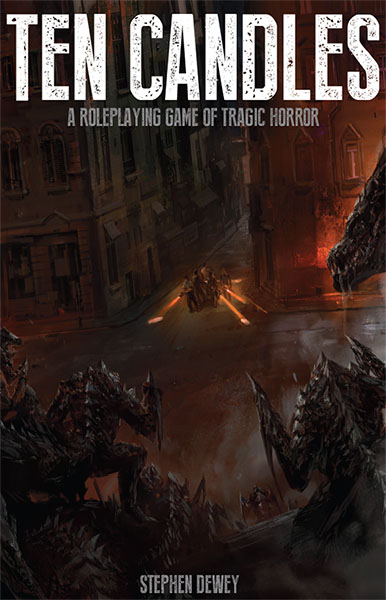
Ten days ago something, or someone, blotted out the sky. Now no stars can be seen, all communication with satellites has been lost, and the sun no longer lights up the sky. Five days ago, They came. No one knows who or what They are, but two very important things are clear:
They fear the light.
They’re coming for you.
Ten Candles is a masterful storytelling game by Stephen Dewey. The basic premise of the game remains the same every time you play: The sun and stars went out. They came. You and a handful of other survivors are clinging to flickering sources of light and trying to find a safe haven. But the mechanics of the game vary the identity, nature, and goals They possess, and this can be combined with an almost endless variety of starting conditions (which the book amply demonstrates by including twenty-five radically different modules) to create something unique and special every time you play.
Your characters will die. The story we’re going to tell today is not one of survival, but one of hope and loss. This is a story about what happens in the dark and the final few hours in the lives of a group of survivors fighting against it, losing themselves within it, and inevitably being consumed by it. Though their endeavor may be doomed to fail, it is our duty to make this story of their struggle as meaningful as possible.
During character creation, two major things will happen: First, your character will be defined by a Vice, a Virtue, a Hope (a moment which will give your character hope if it occurs during the game), and a Brink (the place to which your character can be pushed when things become desperate; and a place to which one of the other characters at the table has seen you go before). Second, ten candles are lit in the middle of the table.
Once character creation is completed, the first scene begins. The players receive a communal pool of 10 six-sided dice (equal to the number of lit candles). Whenever a conflict roll needs to be made, the character initiating the conflict rolls the communal dice pool:
- As long as you roll at least one 6, the conflict is successful.
- Any dice that roll 1 are lost and discarded for the rest of the scene.
If the roll results in failure, a candle is darkened and the scene comes to an end. At that point, the communal dice pool is restored to the now reduced number of lit candles, and the GM gets a pool of dice equal to the number of darkened candles which can be rolled in order to seize narrative control of successful conflict rolls away from the players.
The major wrinkle to this simple resolution mechanic is that players can choose to burn their character traits: Each trait is written on a card and placed in a stack when the game begins, allowing each player to burn the top card of their stack. Literally burn it: Light it on a candle’s flame and toss it into a burn pot in the middle of the table. (This doesn’t destroy the character trait in the sense that it still defines who your character is, but it does force each trait of your character to be placed in the spotlight as the game proceeds.) Vices and Virtues can be burned to reroll 1’s. You can attempt to achieve your Hope by staging the moment and making a conflict roll. And your Brink, which is always a character’s last card, can be used to reroll all dice in a check repeatedly… until a check ultimately fails, at which point the Brink card is lost.
Once only one candle remains, unsuccessful conflict rolls now result in the death of the character attempting them. When the last character dies or the last candle burns out, the game concludes.
PERFECT PACING
The atmospheric effect of playing Ten Candles in a darkened room is tremendously effective: The candles going out one by one. The ritualistic elements of burning the cards. It all greatly heightens the mood of horror, suspense, and fatal tragedy engendered by the game’s premise.
But what makes Ten Candles a great game is its perfect control over pacing: Each scene builds in tension as the dice pool dwindles… and dwindles… and dwindles until failure seems absolutely certain and a candle is darkened forever. The restoration of the dice pool relieves this tension, but now the path to desperation is shorter. And so each scene generally becomes shorter, more intense, and more desperate creating an ever-escalating cycle of tension and release.
This simple pacing pattern is expertly disrupted, however, by the Brink mechanics: As the game nears its end, more and more of the characters will be pushed to the edge. And because each Brink survives until a roll is failed, at the very end of the game — as things reach their most desperate level — there is a momentary suspension of hope.
All of this is then thematically colored by the GM’s growing dice pool, allowing the GM to seize narrative control more and more frequently and viscerally creating in the mechanics the loss of control being experienced by the characters.
CONCLUDING THOUGHTS
A few years back I talked about how the fundamental failure of Dread — despite the strength of its core novelty — was the fact that the mechanics of the game ultimately created pacing that was deeply and irrevocably flawed: The collapsing Jenga tower created a similar “rising tension” to the Ten Candles scene mechanics, but on a scale of time which combines poorly with early player elimination and which lacks a satisfying conclusion. Although Ten Candles uses a completely different set of mechanics, I’ve repeatedly found myself comparing the two games because of the similar pacing hard-coded into their mechanics.
And, at the end of the day, I feel like Ten Candles basically just kills Dread and takes its stuff.
The only limitation of Ten Candles is that it’s tied to the central conceit of the sun going out and Them appearing. But I don’t think the ties are particularly tight: Although you might lose the thematic connection which exists between the candles and the loss-of-light premise, there’s really only one step in the character creation process which would need to be adapted for other premises. (There’s one card during Brink phase on which a player writes the Brink for Them. You would need to shift the nature of that card to match whatever survival horror scenario you were running.)
In any case, Ten Candles is great. I’ve only had the game for a couple of weeks and it’s already hit my table multiple times, which is a strong testament to its quality. An even stronger testament, perhaps, is that multiple players have bought copies of their own and are either planning to run or have already run their own sessions. That only happens when a game is getting something very, very right.
In short, Ten Candles nails it.
THESE THINGS ARE TRUE.
THE WORLD IS DARK.
AND WE ARE ALIVE.
Style: 5
Substance: 5
Author: Stephen Dewey
Publisher: Cavalry Games
Print Cost: $28.00
PDF Cost: $10.00
Page Count: 90















